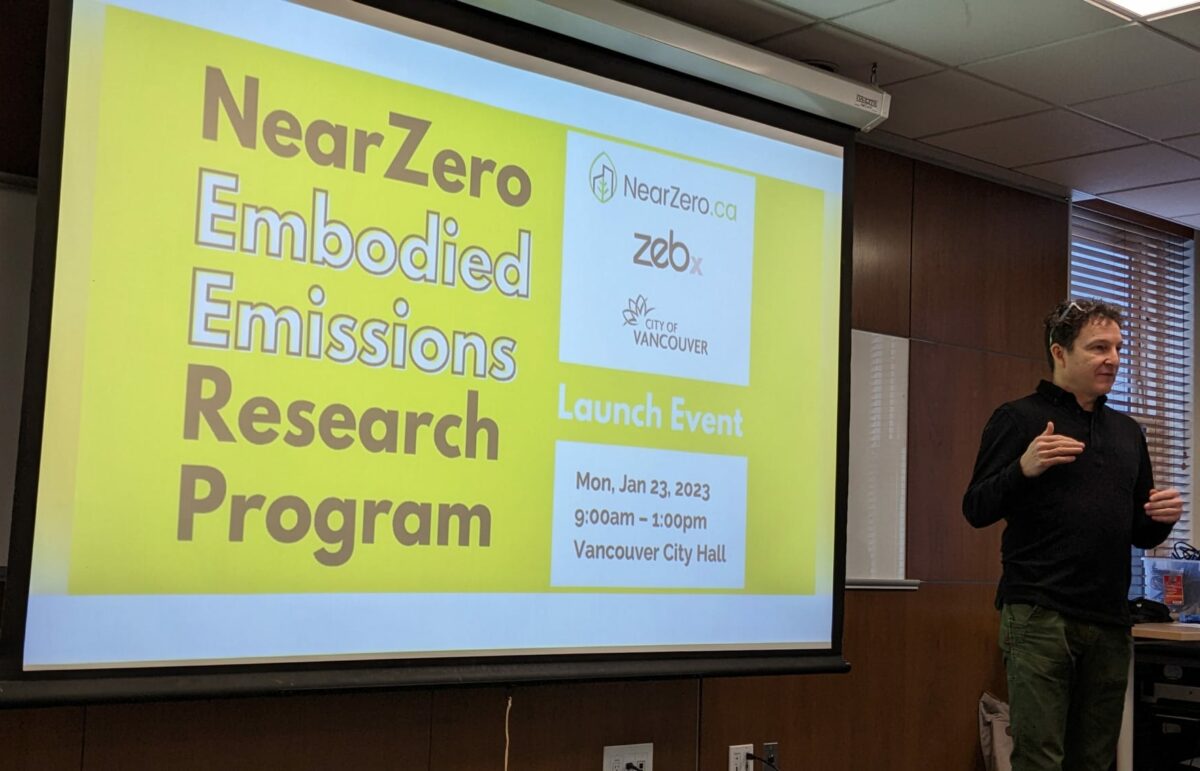June 6, 2023
Caroline Butchart, Program Manager, Embodied Emissions, ZEBx

In early 2023, the Metro Vancouver Zero Emissions Innovation Centre (ZEIC), Metro Vancouver’s LC3 Centre, launched an innovative program that aims to reduce the embodied carbon in new home builds by 40%, coinciding with the City of Vancouver’s target to reduce embodied emissions by 40% by 2030 as part of the City’s declaration of a climate emergency.
Led by ZEIC’s specialized zero emissions building knowledge centre, ZEBx, and undertaken in close collaboration with the City of Vancouver, Stream 2 of the NearZero Program will gather expertise from the local home building community to significantly reduce the carbon impact of the construction of local buildings.
Referred to as “embodied carbon”, this source of emissions has not traditionally been a driver of carbon reduction strategies, which tend to focus more on the emissions associated with a building’s operations after construction. There is growing evidence, however, that the emissions associated with the construction of a building are approximately equivalent to the emissions from building heating, water heating and electricity use – which is largely considered to be the biggest overall source of emissions in most Canadian cities. For background, please see Priopta’s BC Embodied Carbon Modelling Study and the Material Emissions Benchmark Report for Part 9 Homes in Vancouver.
Aside from swapping out key construction components for lower-carbon alternatives, much of the embodied carbon benefit is created by reducing the resources used in creating new buildings, both through simplified designs and more judicious use of materials. For example, while concrete has many benefits in construction, it is carbon intensive to produce, so finding ways to minimize its use by swapping in other building techniques or materials can be one strategy to draw down carbon.
The NearZero Program’s Stream 2 offers an opportunity for local home builders to receive training and resources about low-carbon building materials and construction techniques, including explicit local sources of the best options for low-carbon building products. Program participants choose their own approach to incorporating these strategies into their projects. In return, they are required to report to ZEBx and the City of Vancouver on the practicalities of their approach at both the design stage and once construction is complete.
Applied research collaboration with home builders and the City of Vancouver
The reports will paint a picture of how home builders are adapting these new ideas in the field – to see what works best for the price, how to integrate the new approaches, and to flush out unique creative solutions to practical challenges. To sweeten the deal, participants are then offered special payments for sharing their experience in creating buildings that reduce embodied carbon impacts, ranging from $5,000 for carbon reductions of 30% up to $40,000 for a reduction of 80-100%.
The key to the program is capturing and mobilizing valuable information from building professionals about their direct experiences with low-carbon products and techniques. ZEBx’s role is to curate peer-to-peer information exchanges that will allow builders to speak directly to one another about their work in this area, and how it affects central issues like overall building cost and time to build. Another important component provided by ZEBx is the compilation and maintenance of a low carbon materials sourcing guide to help buildings locate and price out products.
This applied research program will offer new data and on-the-ground insights to inform future building standards to be applied by the City of Vancouver and to support materials innovation in new builds while ensuring the best practices are scaled out city-wide.
Reinforcing work within the LC3 Network
As a member of the LC3 Network, ZEIC has been able to draw on as well as inform other cities’ work in the area of embodied carbon, via its ZEBx initiatives. For example, in 2020, The Atmospheric Fund, the LC3 Centre for the Greater Toronto and Hamilton Area (GTHA), provided a grant to Passive Buildings Canada to examine data from over 500 residential buildings built between 2017 and 2020 in the GTHA, benchmarking emissions from the materials used in their construction.
The Passive Buildings Canada study created the largest ever data set of embodied carbon information in residential buildings and identified which materials/assemblies are responsible for the most emissions. Embodied carbon emissions across the study’s sample averaged 191 kg C02e/m2 of embodied carbon, with a range between best performers at 116 kg C02e/m2 and worst at 561. Extrapolating the study’s average values to all new low-rise homes built each year in the GTHA, the total impact is equivalent to the emissions from more than 183,000 automobiles.
The report identified opportunities for significant reductions by comparing options for each material, and demonstrated that a limited number of available, affordable, and code-compliant material substitutions could result in reducing emissions by 50 to 75%. The study provided policymakers, developers, builders, and homeowners with insights about choices they can make to reduce GHG emissions in the homes they build or renovate. And the City of Toronto used the report to consider an embodied carbon cap in version 4 of the Toronto Green Standards.

In addition, Chris Magwood, the author of this report, presented his guidelines for embodied emissions reductions at the ZEBx NearZero launch event, sharing advice on multiple paths local builders could take to reduce their emissions.
As ZEBx’ Embodied Emissions program manager, what excites me most about this new initiative is the enthusiasm we are already seeing among the Metro Vancouver home-builder community. Even during our launch event, builders were already eager to ask questions and exchange their ideas about embodied carbon reduction techniques. The program also showcases a very productive partnership between ZEBx and the City of Vancouver, where complementary roles and skills are combining to make the multiple streams of the NearZero program very successful in translating practitioner experience into strong local policy.
Caroline Butchart